Abstract
Bradyrhizobium japonicum expresses hydrogenase in microaerophilic free-living conditions in the presence of nickel. Plasmid-borne hup-lacZ transcriptional fusion constructs were used to study the regulation of the hydrogenase gene. The hydrogenase gene was transcriptionally induced under microaerobic conditions (0.1 to 3.0% partial pressure O2). The hydrogenase gene was not transcribed or was poorly transcribed in strictly anaerobic conditions or conditions above 3.0% O2. Hydrogen gas at levels as low as 0.1% partial pressure induced hydrogenase transcription, and a high level of transcription was maintained up to at least 10% H2 concentration. No transcription was observed in the absence of H2. Hydrogenase was regulated by H2, O2, and Ni when the 5'-upstream sequence was pared down to include base number -168. However, when the upstream sequence was pared down to base number -118, the regulatory response to O2, H2, and Ni levels was negated. Thus, a common cis-acting regulatory region localized within 50 bp is critical for the regulation of hydrogenase by hydrogen, oxygen, and nickel. As a control, the B. japonicum hemA gene which codes for delta-aminolevulinic acid synthase was also fused to the promoterless lacZ gene, and its regulation was tested in the presence of various concentrations of O2 and H2. hemA-lacZ transcription was not dependent on levels of Ni, O2, or H2. Two different hup-lacZ fusions were tested in a Hup- background, strain JH47; these hup-lacZ constructs in JH47 demonstrated dependency on nickel, O2, and H2, indicating that the hydrogenase protein itself is not a sensor for regulation by O2, H2, or nickel.
Full text
PDF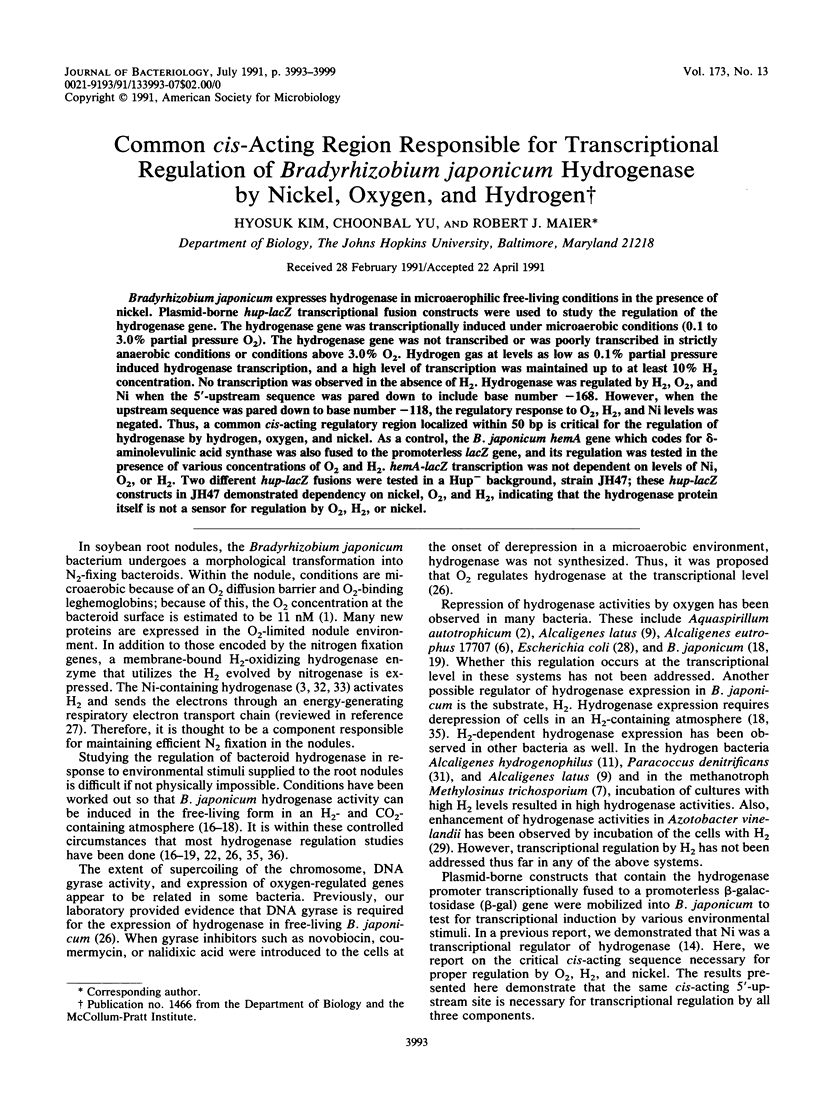
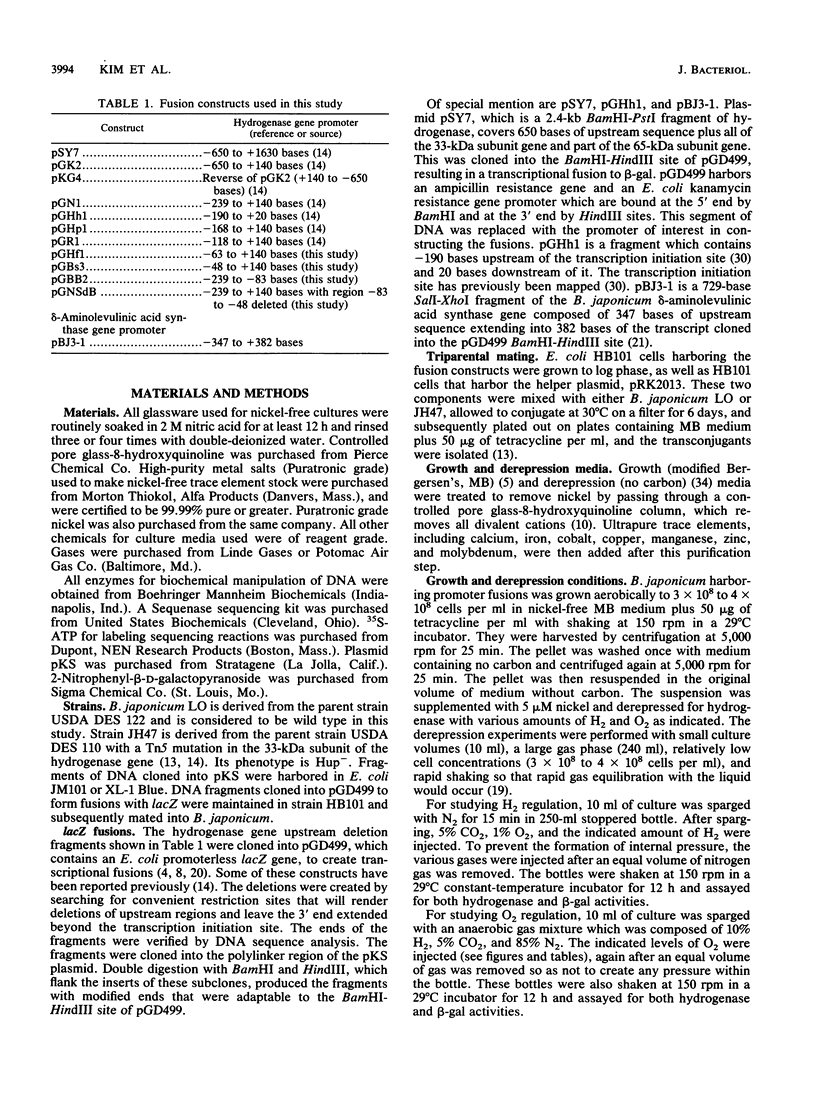
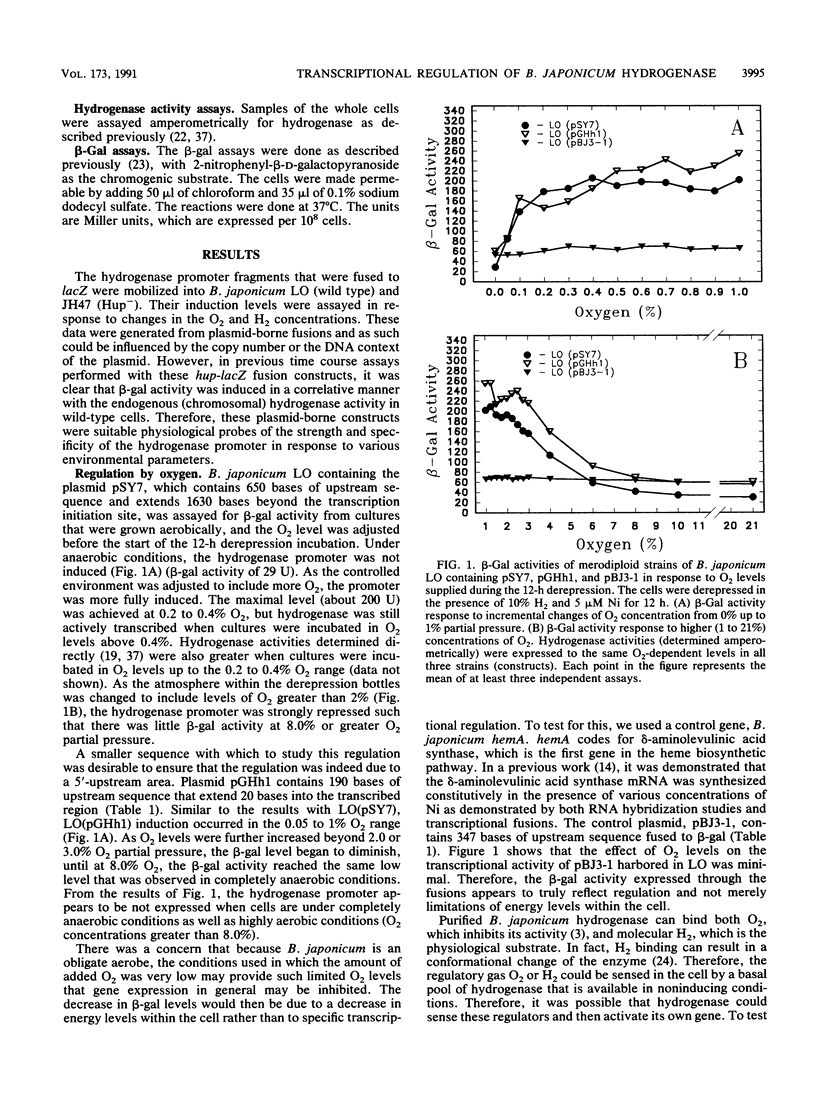
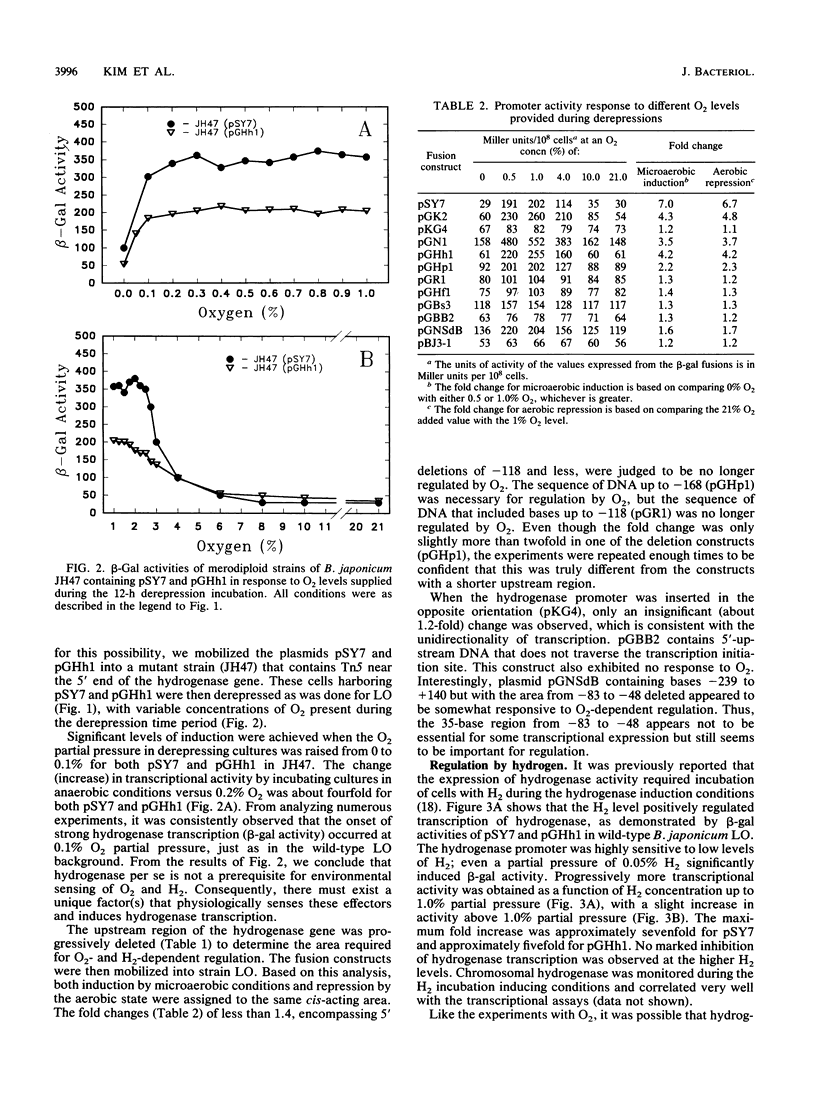

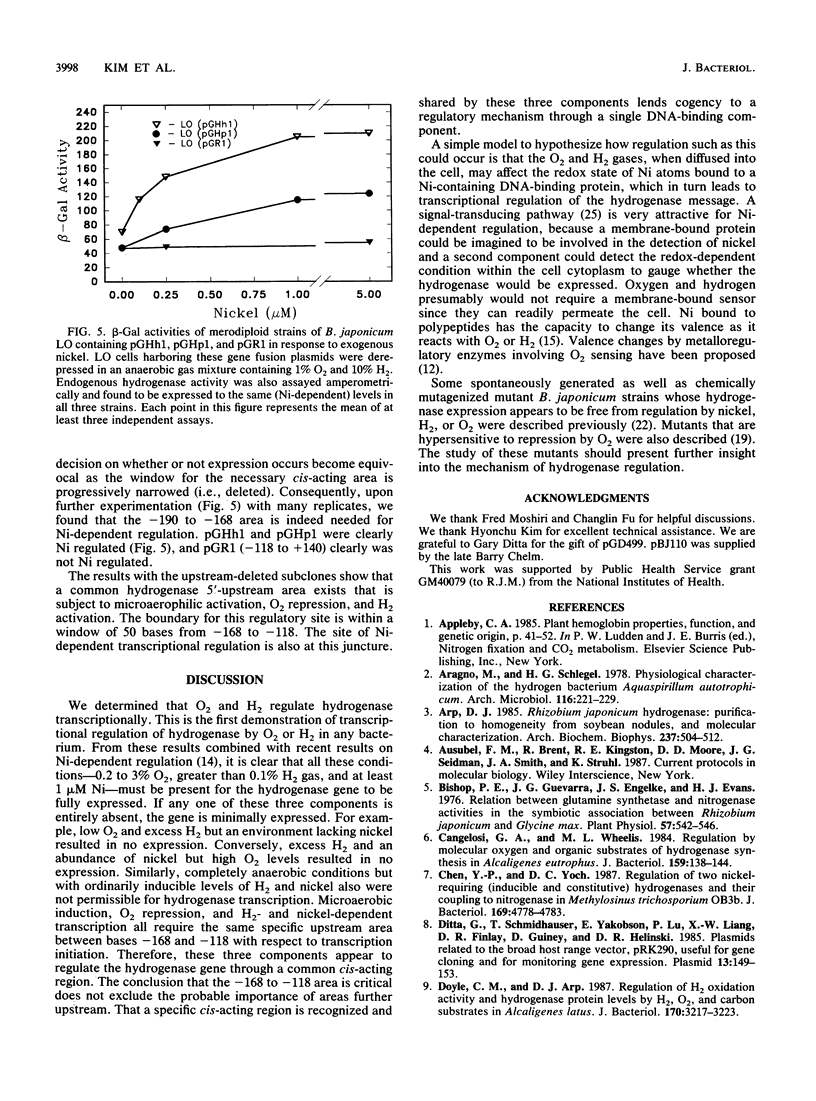
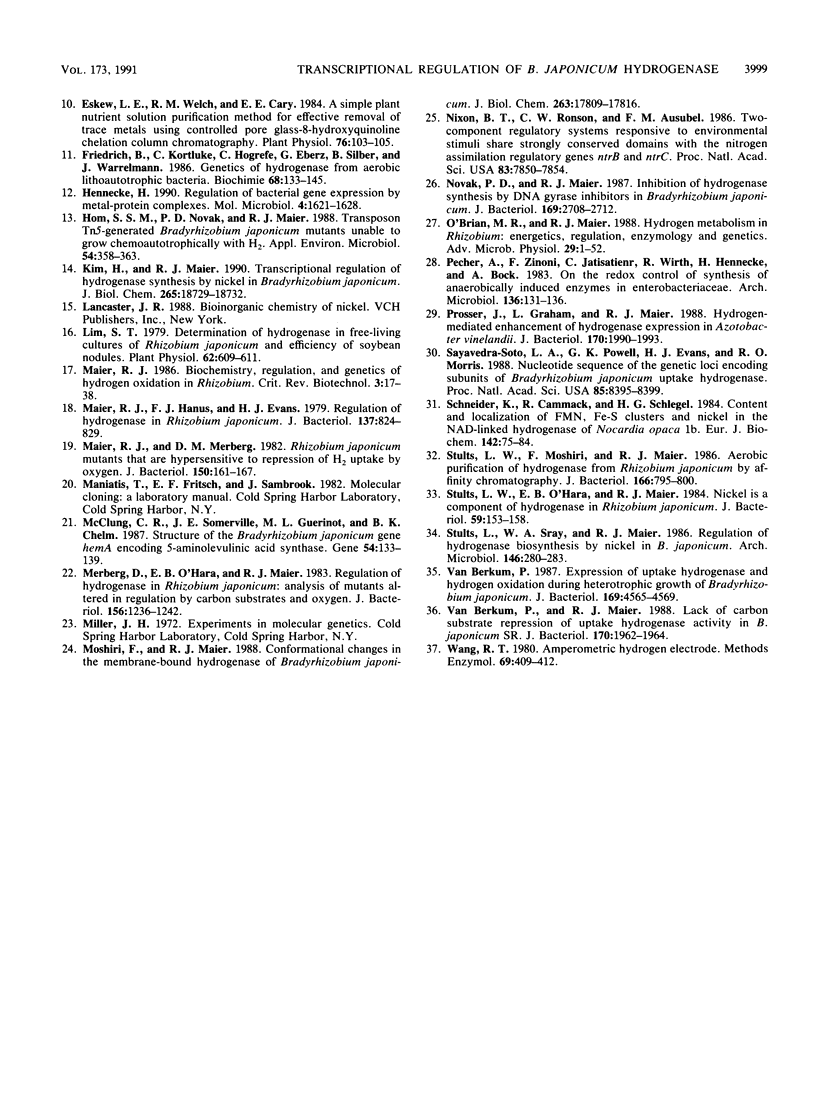
Selected References
These references are in PubMed. This may not be the complete list of references from this article.
- Arp D. J. Rhizobium japonicum hydrogenase: purification to homogeneity from soybean nodules, and molecular characterization. Arch Biochem Biophys. 1985 Mar;237(2):504–512. doi: 10.1016/0003-9861(85)90303-0. [DOI] [PubMed] [Google Scholar]
- Bishop P. E., Guevara J. G., Engelke J. A., Evans H. J. Relation between Glutamine Synthetase and Nitrogenase Activities in the Symbiotic Association between Rhizobium japonicum and Glycine max. Plant Physiol. 1976 Apr;57(4):542–546. doi: 10.1104/pp.57.4.542. [DOI] [PMC free article] [PubMed] [Google Scholar]
- Cangelosi G. A., Wheelis M. L. Regulation by molecular oxygen and organic substrates of hydrogenase synthesis in Alcaligenes eutrophus. J Bacteriol. 1984 Jul;159(1):138–144. doi: 10.1128/jb.159.1.138-144.1984. [DOI] [PMC free article] [PubMed] [Google Scholar]
- Chen Y. P., Yoch D. C. Regulation of two nickel-requiring (inducible and constitutive) hydrogenases and their coupling to nitrogenase in Methylosinus trichosporium OB3b. J Bacteriol. 1987 Oct;169(10):4778–4783. doi: 10.1128/jb.169.10.4778-4783.1987. [DOI] [PMC free article] [PubMed] [Google Scholar]
- Ditta G., Schmidhauser T., Yakobson E., Lu P., Liang X. W., Finlay D. R., Guiney D., Helinski D. R. Plasmids related to the broad host range vector, pRK290, useful for gene cloning and for monitoring gene expression. Plasmid. 1985 Mar;13(2):149–153. doi: 10.1016/0147-619x(85)90068-x. [DOI] [PubMed] [Google Scholar]
- Eskew D. L., Welch R. M., Cary E. E. A simple plant nutrient solution purification method for effective removal of trace metals using controlled pore glass-8-hydroxyquinoline chelation column chromatography. Plant Physiol. 1984 Sep;76(1):103–105. doi: 10.1104/pp.76.1.103. [DOI] [PMC free article] [PubMed] [Google Scholar]
- Friedrich B., Kortlüke C., Hogrefe C., Eberz G., Silber B., Warrelmann J. Genetics of hydrogenase from aerobic lithoautotrophic bacteria. Biochimie. 1986 Jan;68(1):133–145. doi: 10.1016/s0300-9084(86)81078-1. [DOI] [PubMed] [Google Scholar]
- Hennecke H. Regulation of bacterial gene expression by metal-protein complexes. Mol Microbiol. 1990 Oct;4(10):1621–1628. doi: 10.1111/j.1365-2958.1990.tb00538.x. [DOI] [PubMed] [Google Scholar]
- Hom S. S., Novak P. D., Maier R. J. Transposon Tn5-Generated Bradyrhizobium japonicum Mutants Unable To Grow Chemoautotrophically with H(2). Appl Environ Microbiol. 1988 Feb;54(2):358–363. doi: 10.1128/aem.54.2.358-363.1988. [DOI] [PMC free article] [PubMed] [Google Scholar]
- Kim H., Maier R. J. Transcriptional regulation of hydrogenase synthesis by nickel in Bradyrhizobium japonicum. J Biol Chem. 1990 Nov 5;265(31):18729–18732. [PubMed] [Google Scholar]
- Lim S. T. Determination of Hydrogenase in Free-living Cultures of Rhizobium japonicum and Energy Efficiency of Soybean Nodules. Plant Physiol. 1978 Oct;62(4):609–611. doi: 10.1104/pp.62.4.609. [DOI] [PMC free article] [PubMed] [Google Scholar]
- Maier R. J., Hanus F. J., Evans H. J. Regulation of hydrogenase in Rhizobium japonicum. J Bacteriol. 1979 Feb;137(2):825–829. doi: 10.1128/jb.137.2.825-829.1979. [DOI] [PMC free article] [PubMed] [Google Scholar]
- Maier R. J., Merberg D. M. Rhizobium japonicum mutants that are hypersensitive to repression of H2 uptake by oxygen. J Bacteriol. 1982 Apr;150(1):161–167. doi: 10.1128/jb.150.1.161-167.1982. [DOI] [PMC free article] [PubMed] [Google Scholar]
- McClung C. R., Somerville J. E., Guerinot M. L., Chelm B. K. Structure of the Bradyrhizobium japonicum gene hemA encoding 5-aminolevulinic acid synthase. Gene. 1987;54(1):133–139. doi: 10.1016/0378-1119(87)90355-6. [DOI] [PubMed] [Google Scholar]
- Merberg D., O'Hara E. B., Maier R. J. Regulation of hydrogenase in Rhizobium japonicum: analysis of mutants altered in regulation by carbon substrates and oxygen. J Bacteriol. 1983 Dec;156(3):1236–1242. doi: 10.1128/jb.156.3.1236-1242.1983. [DOI] [PMC free article] [PubMed] [Google Scholar]
- Moshiri F., Maier R. J. Conformational changes in the membrane-bound hydrogenase of Bradyrhizobium japonicum. Evidence that the redox state of the enzyme affects its accessibility to protease and membrane-impermeant reagents. J Biol Chem. 1988 Nov 25;263(33):17809–17816. [PubMed] [Google Scholar]
- Nixon B. T., Ronson C. W., Ausubel F. M. Two-component regulatory systems responsive to environmental stimuli share strongly conserved domains with the nitrogen assimilation regulatory genes ntrB and ntrC. Proc Natl Acad Sci U S A. 1986 Oct;83(20):7850–7854. doi: 10.1073/pnas.83.20.7850. [DOI] [PMC free article] [PubMed] [Google Scholar]
- Novak P. D., Maier R. J. Inhibition of hydrogenase synthesis by DNA gyrase inhibitors in Bradyrhizobium japonicum. J Bacteriol. 1987 Jun;169(6):2708–2712. doi: 10.1128/jb.169.6.2708-2712.1987. [DOI] [PMC free article] [PubMed] [Google Scholar]
- O'Brian M. R., Maier R. J. Hydrogen metabolism in Rhizobium: energetics, regulation, enzymology and genetics. Adv Microb Physiol. 1988;29:1–52. doi: 10.1016/s0065-2911(08)60345-8. [DOI] [PubMed] [Google Scholar]
- Pecher A., Zinoni F., Jatisatienr C., Wirth R., Hennecke H., Böck A. On the redox control of synthesis of anaerobically induced enzymes in enterobacteriaceae. Arch Microbiol. 1983 Nov;136(2):131–136. doi: 10.1007/BF00404787. [DOI] [PubMed] [Google Scholar]
- Prosser J., Graham L., Maier R. J. Hydrogen-mediated enhancement of hydrogenase expression in Azotobacter vinelandii. J Bacteriol. 1988 Apr;170(4):1990–1993. doi: 10.1128/jb.170.4.1990-1993.1988. [DOI] [PMC free article] [PubMed] [Google Scholar]
- Sayavedra-Soto L. A., Powell G. K., Evans H. J., Morris R. O. Nucleotide sequence of the genetic loci encoding subunits of Bradyrhizobium japonicum uptake hydrogenase. Proc Natl Acad Sci U S A. 1988 Nov;85(22):8395–8399. doi: 10.1073/pnas.85.22.8395. [DOI] [PMC free article] [PubMed] [Google Scholar]
- Schneider K., Cammack R., Schlegel H. G. Content and localization of FMN, Fe-S clusters and nickel in the NAD-linked hydrogenase of Nocardia opaca 1b. Eur J Biochem. 1984 Jul 2;142(1):75–84. doi: 10.1111/j.1432-1033.1984.tb08252.x. [DOI] [PubMed] [Google Scholar]
- Stults L. W., Moshiri F., Maier R. J. Aerobic purification of hydrogenase from Rhizobium japonicum by affinity chromatography. J Bacteriol. 1986 Jun;166(3):795–800. doi: 10.1128/jb.166.3.795-800.1986. [DOI] [PMC free article] [PubMed] [Google Scholar]
- Stults L. W., O'Hara E. B., Maier R. J. Nickel is a component of hydrogenase in Rhizobium japonicum. J Bacteriol. 1984 Jul;159(1):153–158. doi: 10.1128/jb.159.1.153-158.1984. [DOI] [PMC free article] [PubMed] [Google Scholar]
- van Berkum P. Expression of uptake hydrogenase and hydrogen oxidation during heterotrophic growth of Bradyrhizobium japonicum. J Bacteriol. 1987 Oct;169(10):4565–4569. doi: 10.1128/jb.169.10.4565-4569.1987. [DOI] [PMC free article] [PubMed] [Google Scholar]
- van Berkum P., Maier R. J. Lack of carbon substrate repression of uptake hydrogenase activity in Bradyrhizobium japonicum SR. J Bacteriol. 1988 Apr;170(4):1962–1964. doi: 10.1128/jb.170.4.1962-1964.1988. [DOI] [PMC free article] [PubMed] [Google Scholar]


